|
|
|
Sort Order |
|
|
|
Items / Page
|
|
|
|
|
|
|
| Srl | Item |
| 1 |
ID:
152070
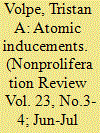

|
|
|
|
|
| Summary/Abstract |
This article argues for an updated strategy to limit the spread of sensitive nuclear technology around the globe. Traditional efforts by the United States to deny countries access to enrichment and reprocessing (ENR) technology are becoming difficult to enforce, while the threat of sanctions against US allies with legal nuclear-energy programs is not credible. As a result, the United States should shift toward a strategy of “buying out” an ally’s ambition for sensitive nuclear technology. Offering military, political, and economic assistance in exchange for stringent nonproliferation commitments will only work when offered at the earliest stage of technical development, before the country builds capabilities that will be difficult or expensive to give up. While there are some practical challenges to implementing such a strategy, the conditions are right to see if lucrative nuclear-energy offers—notably spent-waste management solutions—can induce countries with new civil nuclear programs to foreclose the option to develop ENR technology in the future.
|
|
|
|
|
|
|
|
|
|
|
|
|
|
|
|
| 2 |
ID:
152058
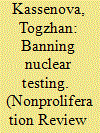

|
|
|
|
|
| Summary/Abstract |
In the late 1940s, the Soviet Union rushed to build and test its first nuclear bomb to reach parity with the United States. The Soviet government chose the steppes of Kazakhstan as its first nuclear-testing site. In difficult conditions, weapons program participants built the site and, in 1949, tested the first Soviet nuclear bomb. Shrouded in secrecy, the Soviet military complex continued to conduct nuclear tests in Kazakhstan for forty years while the local population became an unwilling victim of the Soviet nuclear might. Nuclear tests, especially during the earlier years of atmospheric testing, resulted in severe health and environmental consequences for thousands of nearby residents. Mass protests in Kazakhstan against nuclear tests built the momentum that drove the Kazakh government's decision to close down the Semipalatinsk nuclear-testing site in 1989. Organized public movement against nuclear testing became an important part of Kazakhstan’s nation-building process. Since closing down the site, Kazakhstan has prioritized nuclear disarmament and nonproliferation, using its tragic nuclear past as a platform for making meaningful contributions to international security. Kazakhstan now offers the former nuclear-test site at Semipalatinsk for exercises designed to strengthen the verification capacity of the Comprehensive Nuclear-Test-Ban Treaty (CTBT). The country also plays a leading role in promoting CTBT entry into force.
|
|
|
|
|
|
|
|
|
|
|
|
|
|
|
|
| 3 |
ID:
152052


|
|
|
|
|
| Summary/Abstract |
After participating in the negotiations on the Comprehensive Nuclear-Test-Ban Treaty at the Conference on Disarmament in Geneva, I was elected the first executive secretary of the organization and started my work in 1997. At that time, we hoped that the treaty would enter into force only a few years after the International Monitoring System would be working. But today, twenty years after opening for signature, we are still waiting. The reason is a rather complicated formula for entry into force: all states with nuclear capabilities at the time of the treaty's negotiation must ratify.
|
|
|
|
|
|
|
|
|
|
|
|
|
|
|
|
| 4 |
ID:
152057
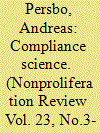

|
|
|
|
|
| Summary/Abstract |
The Comprehensive Nuclear-Test-Ban Treaty's verification regime is arguably one of the most effective and efficient systems of arms-control and disarmament monitoring in operation today. The science and technology underpinning the system have been developed over several decades. This article goes through the treaty's international monitoring system and pays particular attention to its waveform-monitoring techniques. It then considers the concept of data fusion, before describing the agreement's on-site-inspection mechanism. It briefly discusses how alleged noncompliance is likely to be resolved. It concludes by arguing that the treaty's verification regime is expected to make cheating costly, which enhances the treaty's deterrent effect.
|
|
|
|
|
|
|
|
|
|
|
|
|
|
|
|
| 5 |
ID:
152064


|
|
|
|
|
| Summary/Abstract |
The fate of the Comprehensive Nuclear-Test-Ban Treaty (CTBT) is closely connected to US attitudes toward the treaty, which in turn depend upon US perceptions of how the treaty affects US security. There have been wild swings in these perceptions since the treaty was signed in 1996. Impressive progress has been made in the ability to verify the CTBT in recent years, both in the International Monitoring System and in the possible use of on-site inspections. Questions remain in the minds of opponents regarding the treaty's possible effect on the US nuclear stockpile, as well as the treaty's overall relationship to nonproliferation. The new Trump administration will need to decide how to proceed on this crucial piece of unfinished business. In addition to finally ratifying the treaty, other options are possible.
|
|
|
|
|
|
|
|
|
|
|
|
|
|
|
|
| 6 |
ID:
152063
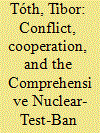

|
|
|
|
|
| Summary/Abstract |
The methods and concepts used to monitor and predict economic trends can offer a helpful approach in determining the future of the nuclear-test-ban regime. Like the global financial and economic markets, competitive security can be viewed as undergoing “boom-and-bust” cycles, wherein “overinvestment” in competition will inevitably result in a “burst bubble,” which prompts “regulatory” mechanisms to reign in competition through cooperative measures. These conceptual models offer some utility in understanding international security and the prospects for achieving entry into force of the Comprehensive Nuclear-Test-Ban Treaty.
|
|
|
|
|
|
|
|
|
|
|
|
|
|
|
|
| 7 |
ID:
152060


|
|
|
|
|
| Summary/Abstract |
The June 13, 2016, ministerial meeting of the Preparatory Commission of the Comprehensive Test-Ban Treaty Organization marked the twentieth anniversary of the signing of the treaty and the establishment of the commission. The ministerial sent a strong signal of political support for and commitment to the treaty. Ministers noted with appreciation the organization's achievements related to the detection and deterrence of nuclear-test explosions while also regretting the delay in ratification by the Annex II states. The ministerial emphasized, as the key parameters of the future strategy, the importance of a multilayered approach, including the importance of track-two diplomacy and the use of communication technology that did not exist twenty years ago.
|
|
|
|
|
|
|
|
|
|
|
|
|
|
|
|
| 8 |
ID:
152059


|
|
|
|
|
| Summary/Abstract |
Twenty years after the establishment of the Preparatory Commission charged with setting up the Comprehensive Nuclear-Test-Ban Treaty Organization, the CTBT is still not in force. Nevertheless, based on the legal instruments adopted in 1996 by the state signatories, the commission has standing as a full-fledged international organization with the legal capacity needed for the exercise of its functions and the fulfillment of its purposes. Moreover, the verification technologies developed by the organization have triggered manifold effects, particularly for disaster warning and response. Irrespective of CTBT entry into force, the commission is playing a relevant role in monitoring nuclear testing as well as in delivering the benefits of verification technologies to the international community.
|
|
|
|
|
|
|
|
|
|
|
|
|
|
|
|
| 9 |
ID:
152071
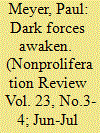

|
|
|
|
|
| Summary/Abstract |
International cooperation on outer-space security has fluctuated over the past decades, marked by periods of common endeavor and relative stability as well as times of destabilizing developments and rising tensions. A high-water mark of space-security diplomacy was the 2013 UN Group of Governmental Experts consensus report on “Transparency and Confidence-Building Measures in Outer Space Activities,” which set out a rich menu of measures and promised new levels of cooperative security among states. Regrettably, the report was followed by a series of negative developments that threaten to reverse the cooperative trend it espoused. These developments include the introduction (by Russia and China) and rejection (by the United States) of a revised draft treaty on the Prevention of Placement of Weapons in Outer Space (PPWT); the adoption by the UN General Assembly of a divisive resolution on “no first placement” of space weapons; the failure of the European Union to gain support for its proposed Code of Conduct, as well as escalating strategic tensions. This viewpoint analyzes the re-emergence of these “dark forces” and their implications for multilateral diplomacy and makes suggestions for remedial action to preserve outer-space security.
|
|
|
|
|
|
|
|
|
|
|
|
|
|
|
|
| 10 |
ID:
152065
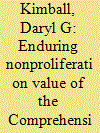

|
|
|
|
|
| Summary/Abstract |
Twenty years after the opening for signature of the CTBT, the treaty has near universal support and has established a global norm against nuclear-test explosions. The nuclear-testing taboo impedes the development of new and more advanced nuclear-warhead designs, which helps prevent dangerous nuclear competition and maintain international security. The treaty's international test-monitoring regime is nearly complete and already detects and deters clandestine nuclear explosions, even ahead of entry into force of the treaty. The UN Security Council's adoption in September 2016 of a resolution on the test ban has reinforced the norm against testing and reaffirmed global support for the treaty. But in order to realize the full potential of the treaty and close the door on testing, states need to undertake new and sustained diplomatic efforts that underscore the political and security value of the treaty for each of the hold-out states.
|
|
|
|
|
|
|
|
|
|
|
|
|
|
|
|
| 11 |
ID:
152055
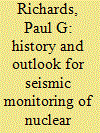

|
|
|
|
|
| Summary/Abstract |
Modern methods of nuclear-explosion monitoring are vastly more capable than they were when underground nuclear testing began in the late 1950s, in part because a cycle of improvements in explosion monitoring in the 1960–80 period led to improvements in monitoring for earthquakes and other phenomena, which then led to a general growth in monitoring assets that in turn has been applied back to explosion monitoring. Practical experiences in nuclear-explosion monitoring, acquired during the era of active testing prior to finalization of the CTBT text in 1996, laid the basis for monitoring in support of this arms-control initiative. This article elaborates on the future of nuclear-test-monitoring technology, which can build upon an additional and remarkable growth of general monitoring assets that began in the 1990s, largely unrelated to the specifics of nuclear-test monitoring. A new cycle of improvements in earthquake monitoring is likely to improve monitoring for explosions. While it is not easy to quantify the degree of monitoring improvement afforded by such new assets, an example from North Korea indicates the improvement can be substantial.
|
|
|
|
|
|
|
|
|
|
|
|
|
|
|
|
| 12 |
ID:
152067


|
|
|
|
|
| Summary/Abstract |
The claim that the spread of nuclear weapons leads to interstate conflict and nuclear war has become very influential. However, proliferation pessimists have failed to specify how and when nuclear proliferation precipitates conflict. I make four arguments for an optimistic pessimism. (1) The few preventive strikes against nuclear facilities that have occurred would have occurred absent of the target's nuclear program, and these rare strikes did not lead to conflict escalation. (2) The problem of nonsurvivable arsenals is, properly understood, a problem of preventive-war motivations where subjective uncertainty reduces the dangers of arsenal survivability. (3) Claims that bias within nuclear organizations may lead to accidental nuclear detonations suffer from omitted variable bias: leaders' decisions to revise the status quo after developing nuclear weapons tend to give rise to the most dangerous nuclear accidents. Accidents that have not occurred during a nuclear crisis pose substantially less risk of nuclear escalation. (4) Leaders of nuclear states have tended to engage in conventional aggression, but experience with nuclear weapons moderates their conflict propensity. Ultimately, I argue that while nuclear weapons have led to conflict through one causal mechanism and for a limited time, the dangers are substantially weaker than usually assumed.
|
|
|
|
|
|
|
|
|
|
|
|
|
|
|
|
| 13 |
ID:
152062


|
|
|
|
|
| Summary/Abstract |
Ambassador Jaap Ramaker of the Netherlands served as chairman of the Comprehensive Nuclear-Test-Ban Treaty (CTBT) negotiations. In this article, Ambassador Ramaker reflects on the negotiating process and the ways in which concrete progress of the CTBT ratification process could enhance international peace and security. Ratification by the two remaining nuclear-weapon states would constitute an essential first step and also create a possible area of cooperation between Russia and then United States on a nuclear issue that, for these two states, has long been non-controversial.
|
|
|
|
|
|
|
|
|
|
|
|
|
|
|
|
| 14 |
ID:
152066
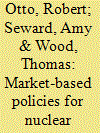

|
|
|
|
|
| Summary/Abstract |
Access to weapon-useable fissile material—highly enriched uranium and separated plutonium—is the primary technical barrier to nuclear-weapon development. Nuclear-nonproliferation policy is largely concerned with the secure distribution and use of these materials and the technologies that produce them. To the extent that both materials and technologies are traded in markets, the problem may be viewed as one of influencing markets to give an acceptable set of allocative outcomes. While governments long ago rejected a laissez-faire approach to these markets, most current policy is based on prescribed or proscribed behavior rather than market incentives. “Market-based” nonproliferation policies would act through incentives in the markets for nuclear materials and technology rather than by prescribing outcomes or behavior. Possible polices of this sort include subsidized enrichment services, credits to impute value to spent nuclear fuel, and new markets for scarce nuclear materials. While market-based policies will not replace command-and-control policies entirely, they could lead to efficient regulation that suffices to guide the choices of most market participants, reserving special, more forceful measures for the few difficult cases.
|
|
|
|
|
|
|
|
|
|
|
|
|
|
|
|
| 15 |
ID:
152069


|
|
|
|
|
| Summary/Abstract |
The development of nuclear weapons by Israel, South Africa, India, Pakistan, and the Democratic People’s Republic of Korea (DPRK)—dubbed “second-generation proliferators”—was initially opaque, in that they did not involve, inter alia, not nuclear testing. Although each of these states' nuclear programs has generally gone from secret to public knowledge, they have taken divergent paths over the years. Israel has maintained its opacity, South Africa has dismantled its weapons, and India, Pakistan, and the DPRK have shifted from opacity to visibility by conducting nuclear tests. The preference for opacity or disclosure can be explained by the balance between factors favoring opacity (norms, diplomatic pressure, and security dilemma) and those favoring disclosure (deterrence, international prestige, and domestic politics). If a new proliferator emerges, it will probably do so opaquely, rather than visibly. To prevent and deny this option, early detection, raising the diplomatic, political, and economic costs of opacity, and steadfast determination not to allow the existence of undeclared nuclear states are key. These points apply to the implementation of the July 2015 Joint Comprehensive Plan of Action (JCPOA) for Iran.
|
|
|
|
|
|
|
|
|
|
|
|
|
|
|
|
| 16 |
ID:
152053


|
|
|
|
|
| Summary/Abstract |
The executive secretary of the Preparatory Commission of the Comprehensive Nuclear-Test-Ban Treaty Organization (CTBTO), Dr. Lassina Zerbo, shares his thoughts on the twentieth anniversary of the signing of the CTBT. He discusses the future of the organization's monitoring technology and explains what would be different, in this regard, if the treaty were in force. Dr. Zerbo also assesses possible mechanisms to promote entry into force, such as through the activities of the Group of Eminent Persons (GEM) and the Youth Group. And when discussing the possibility of a WMD-free zone in the Middle East, Zerbo points out that the CTBT could also enhance nuclear disarmament.
|
|
|
|
|
|
|
|
|
|
|
|
|
|
|
|
| 17 |
ID:
152061


|
|
|
|
|
| Summary/Abstract |
Twenty years after opening for signature, the Comprehensive Nuclear-Test-Ban Treaty still lacks the necessary ratifications to achieve entry into force. The United States is one of the remaining eight nations that needs to complete its ratification process, after the US Senate failed to provide its advice and consent to ratification to the CTBT in 1999. In order to secure that advice and consent now, the executive branch must engage both the American public and the Senate on the clear merits of the treaty.
|
|
|
|
|
|
|
|
|
|
|
|
|
|
|
|
| 18 |
ID:
152068
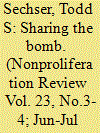

|
|
|
|
|
| Summary/Abstract |
What are the political and strategic consequences of nuclear deployments overseas? The United States continues to maintain around 200 nuclear warheads in Europe, and some observers have called for the United States to redeploy tactical nuclear weapons to the Korean peninsula. This article reviews the insights from recent research on the effects of foreign-deployed nuclear weapons. It asks two central questions. First, does the evidence support the view that foreign nuclear deployments contribute to deterrence? Second, do these deployments strengthen or undermine the Treaty on the Non-Proliferation of Nuclear Weapons? The evidence suggests that foreign nuclear deployments contribute less to deterrence than previously believed. Further, nuclear deployments probably have mixed effects on proliferation. Unanswered questions for further research include the extent to which nuclear-sharing arrangements reassure allies, and the political and strategic consequences of canceling them.
|
|
|
|
|
|
|
|
|
|
|
|
|
|
|
|
| 19 |
ID:
152056
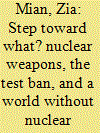

|
|
|
|
|
| Summary/Abstract |
Historically, nuclear-explosive testing was not required to develop simple, reliable, gun-type nuclear weapons with highly enriched uranium as the chain-reacting material. Testing may now not be required to build basic implosion weapons using plutonium. This suggests that, even if no state had ever conducted a nuclear test, a nuclear-armed world could still have emerged, but probably without thermonuclear weapons. The examples of the United States, Russia, the United Kingdom, France, and Pakistan suggest that, despite the twenty-year-old Comprehensive Nuclear-Test-Ban Treaty (CTBT), nuclear-weapon states with very different testing legacies expect to continue developing, and in some cases deploying, new nuclear weapons. The entry into force of the CTBT might not significantly constrain nuclear-weapons development for any state, and a worthwhile goal now may be to focus on other agreements to restrict nuclear weapon activities, in particular an agreement to ban nuclear weapons.
|
|
|
|
|
|
|
|
|
|
|
|
|
|
|
|
| 20 |
ID:
152054
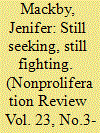

|
|
|
|
|
| Summary/Abstract |
Arms-control advocates have traveled a long road to end nuclear testing. Beginning with the US Baruch Plan and the Soviet Gromyko Plan in 1946, negotiations led to the signing of the Comprehensive Nuclear-Test-Ban Treaty (CTBT) in 1996. Two decades later, a verification regime is up and running, with most of a planned 337 facilities installed around the globe and sending information to a data center in Vienna. Large-scale on-site inspection exercises in Kazakhstan, Jordan, and elsewhere have shown that the planned procedures work. What is missing? Of the forty-four countries that must ratify the treaty for it to enter into force, eight still must proceed with their national measures for ratification. How and why did the negotiators end up with such an unwieldy provision? How did they design such a complex international monitoring system so quickly? This article delves into a brief history of the treaty and its negotiations, highlighting some of the key and most contentious articles of the CTBT, painstakingly arrived at. These include the basic obligations, entry into force, and certain verification issues, including on-site inspections. It also examines the interface of science and technology with diplomacy and politics. Senior diplomats and world-renowned scientists convened in Geneva day and night to hammer out the complex issues involved in verifying compliance with a test ban. They devised a regime that has exceeded their expectations.
|
|
|
|
|
|
|
|
|
|
|
|
|
|
|
|
|
|
|
|
|